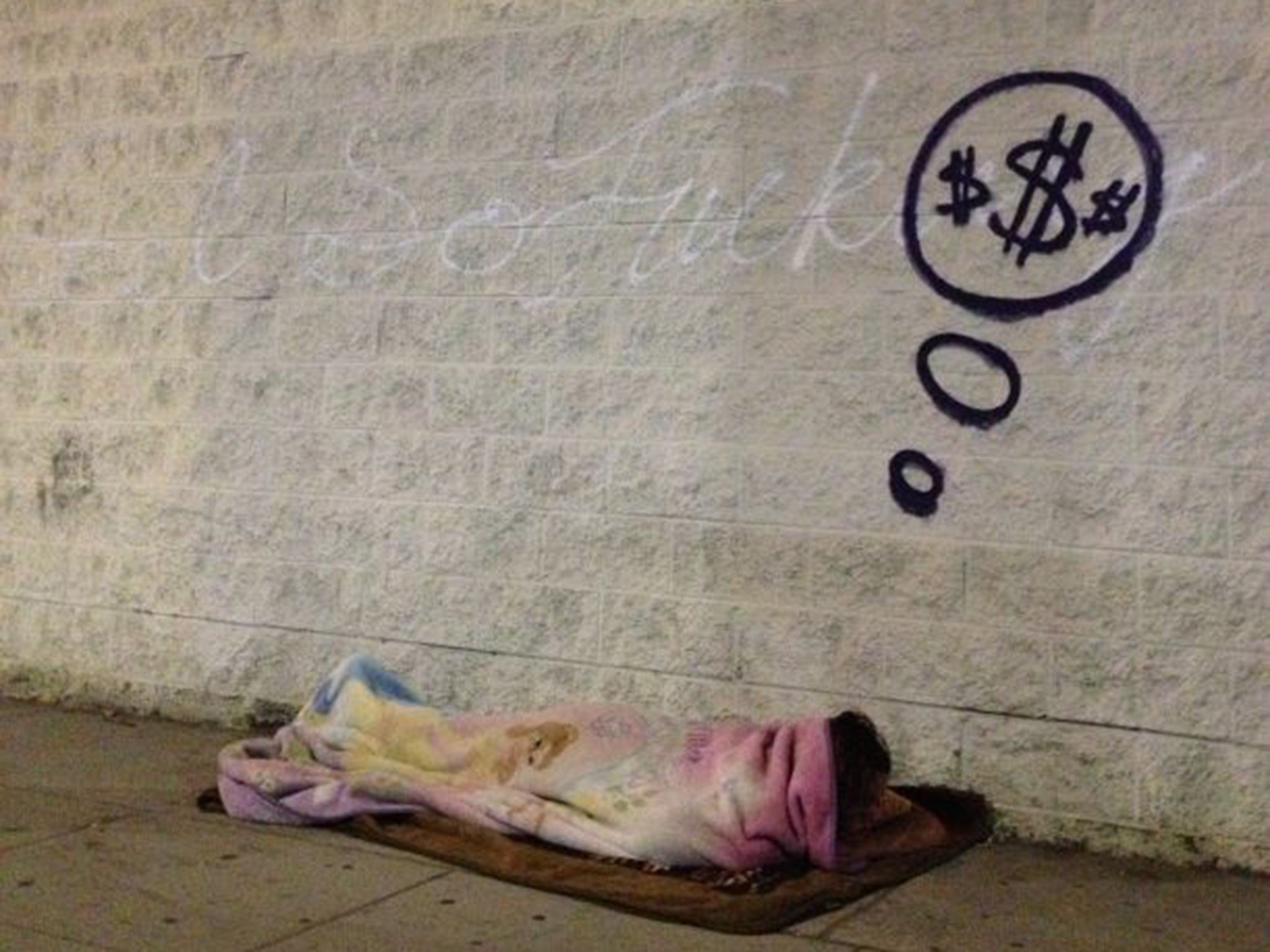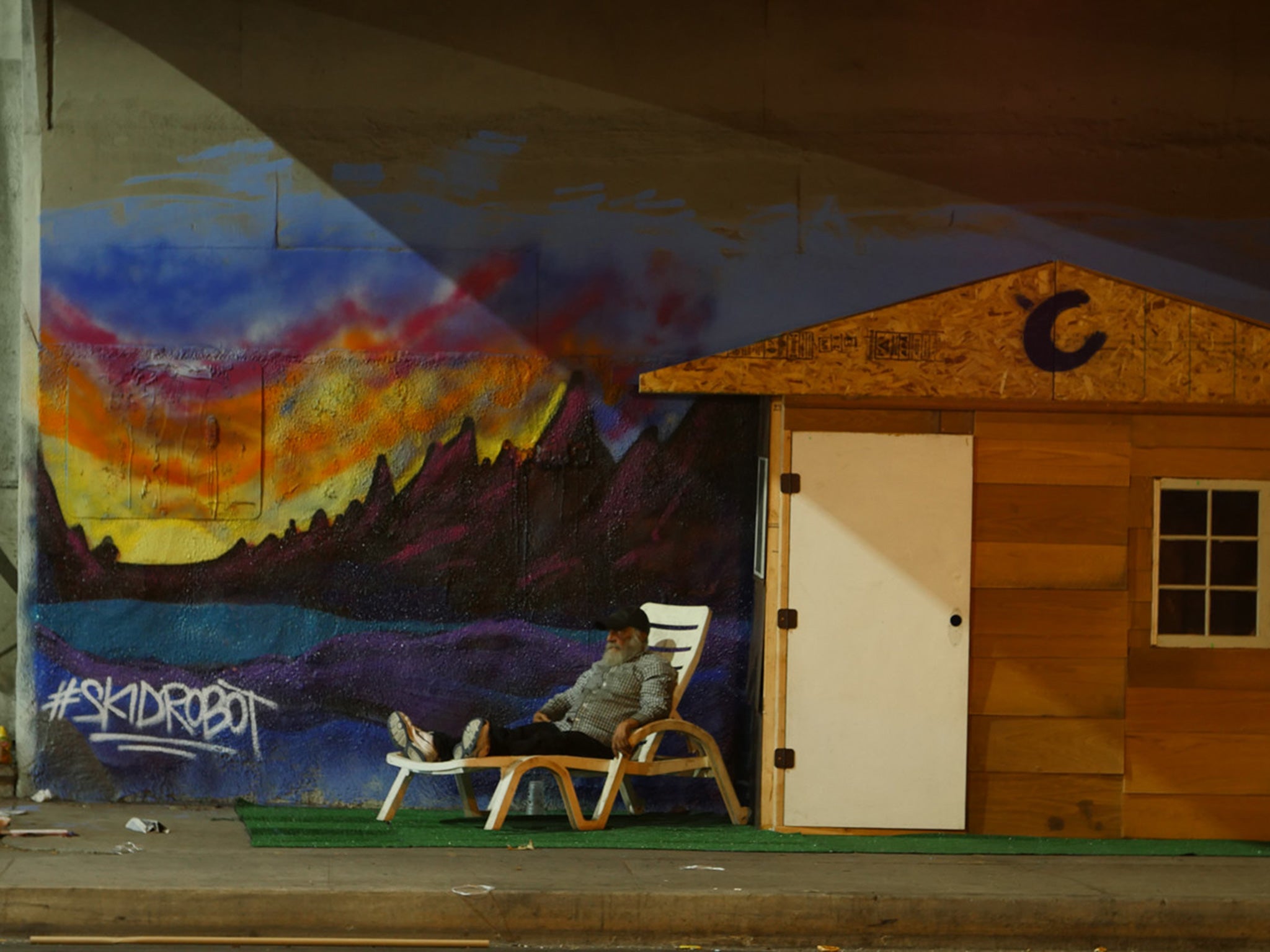Skid Robot: Graffiti activist on publicising the plight of homeless people in Los Angeles
Over the past two years, the number of homeless in LA has grown by 12%

Your support helps us to tell the story
From reproductive rights to climate change to Big Tech, The Independent is on the ground when the story is developing. Whether it's investigating the financials of Elon Musk's pro-Trump PAC or producing our latest documentary, 'The A Word', which shines a light on the American women fighting for reproductive rights, we know how important it is to parse out the facts from the messaging.
At such a critical moment in US history, we need reporters on the ground. Your donation allows us to keep sending journalists to speak to both sides of the story.
The Independent is trusted by Americans across the entire political spectrum. And unlike many other quality news outlets, we choose not to lock Americans out of our reporting and analysis with paywalls. We believe quality journalism should be available to everyone, paid for by those who can afford it.
Your support makes all the difference.It’s mid-afternoon, at the intersection of Central Avenue and Sixth Street in Downtown Los Angeles, and a homeless man slowly pushes a shopping cart filled with his possessions past a chic Mexican restaurant with a parking valet and a four-star Yelp rating.
Here, at the border between LA’s infamous Skid Row and its steadily gentrifying warehouse district, is where The Independent on Sunday has arranged to meet Skid Robot, a graffiti artist and activist, whose work humanises the city’s booming homeless population and illuminates their plight.

Over the past two years, the number of homeless in LA has grown by 12 per cent. In May, the city’s biennial homeless census found more than 44,000 on the streets, at least two-thirds of whom were unsheltered – sleeping rough or in cars. In September, Mayor Eric Garcetti declared a state of emergency, promising a $100m (£66m) plan to combat the crisis.
Homeless encampments have sprung up all over the city, but none is as sprawling or as heart-stopping as Skid Row, an area of four square miles, adjoining Downtown, that hosts probably the single largest concentration of homeless people in the entire United States.
Skid Robot, who describes the area as “third-world living on the same block as first-class luxuries”, creates arresting art that incorporate its neglected denizens by painting the things they lack on to the walls and pavements around them: beds, homes, beautiful views.
He declines to reveal his real name and is deliberately vague about his biography. “If people want to know who the artist is, they’re not asking the more important questions about what the art is about,” he says. But he does concede that he’s aged around 30 and was born and raised in LA. “As a child I was always disciplined for doodling instead of doing homework,” he says. “The neighbourhood I grew up in had a lot of good graffiti, which inspired me to try it myself.”
The Skid Robot persona was born late one night in 2013 while he was out with his then girlfriend in Downtown, complaining about the state of the city’s street-art scene. “I wanted to do something different with my graffiti but I didn’t know what,” he recalls. “We pulled up at a red light in Skid Row and someone was sleeping on the floor nearby.
My girlfriend said: “Why don’t you draw that person dreaming of money?’ Immediately, I thought it was brilliant.”

Skid Robot’s first work took no more than a minute: he spray-painted a thought bubble containing dollar signs above the homeless woman’s head, snapped a picture and later posted it on Instagram. Energised, he made five more similar pieces on the same night, drawing a house around one rough sleeper, a scene of pine trees and a crescent moon behind the tent of another.
A couple of nights later, compelled to help the people who had inspired him, he bought a cache of food and toiletries and began making care packages to hand out to the homeless.
Growing up, Skid Robot’s heroes had been such men as Malcolm X and Subcomandante Marcos, revolutionaries committed to social justice. He sees his graffiti as a form of civil disobedience, and makes a distinction between his deliberate “acts of vandalism” and LA’s more polite, prevalent street art, which often goes hand-in-hand with gentrification.
“Graffiti has always been the voice of people in a revolution,” he says. “If there’s discontent among people, it ends up on the wall. And everyone reads the writing on the wall.”
If anyone agrees with his message but not his medium, he tells them: “Look at the person sleeping underneath the graffiti. Which is the more important issue to solve?”
Last year, Vice published a photograph of a Skid Robot piece in an underpass beneath the 101 freeway in LA’s Echo Park neighbourhood, which led to a worldwide burst of interest in his work. The homeless man in that image is known as Birdman, a charismatic, some-time songwriter who says he has lived under the same bridge for 20 years.
Recently, the city’s authorities dismantled the tiny, makeshift wooden house the artist had helped to build for Birdman, and covered up the mountain scene he’d painted on the wall behind. “I was like, ‘This isn’t cool, man. This wasn’t vulgar, it wasn’t hurting anybody. It was providing temporary shelter to somebody who desperately needs it and who I consider a friend,’” he says.
Sceptical of the city’s $100m plan, Skid Robot is setting up his own not-for-profit company to provide small, prefabricated modular homes to people on the street, for which he would create miniature murals. “My vision is for art to be a solution to the housing crisis,” he says. He is raising the funds in part by selling prints via his website (skid-robot.com).
The artist is also involved in an initiative to house homeless families and veterans, in collaboration with a local shelter and the LAPD’s Skid Row division. As he becomes more of an active campaigner, Skid Robot acknowledges that he’ll have to work harder to maintain his secret identity, admitting: “It’s kind of a Bruce Wayne/Batman deal.”
Join our commenting forum
Join thought-provoking conversations, follow other Independent readers and see their replies
Comments